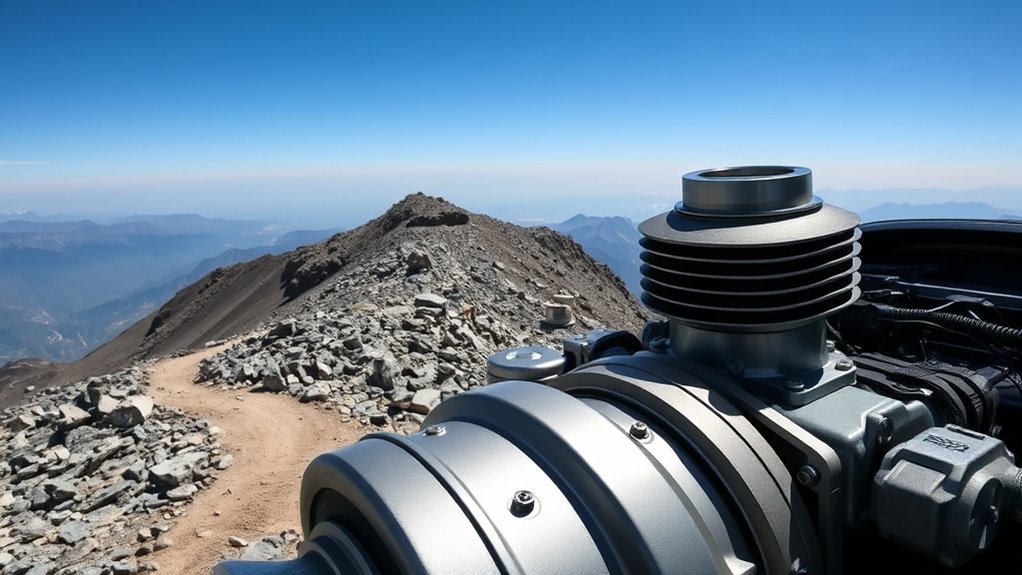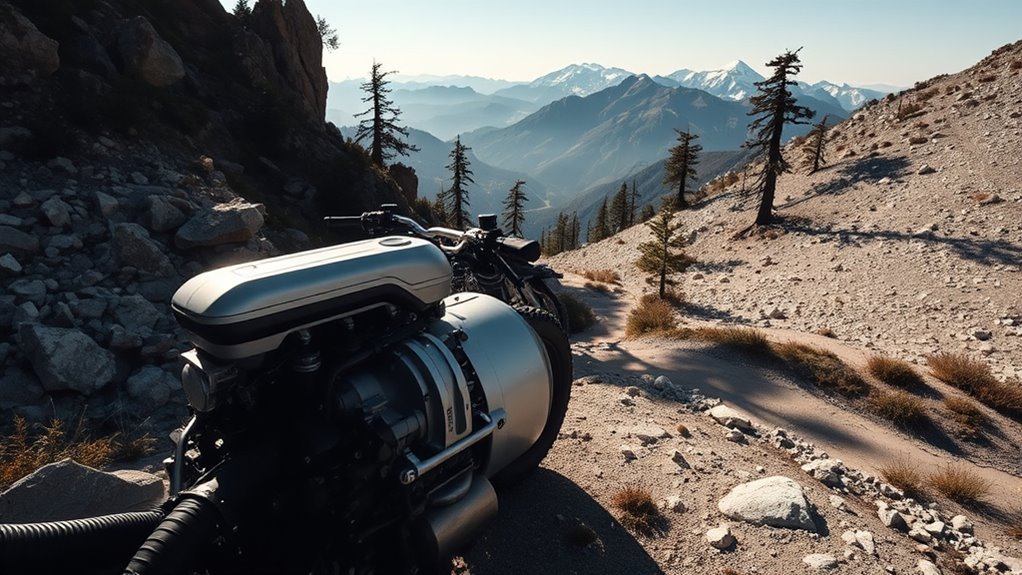At higher altitudes, your vehicle’s engine produces less power because the thinner air has less oxygen for combustion. This means your engine runs less efficiently, causing reduced torque and responsiveness. Turbocharged engines also lose boost, and unadjusted fuels can run richer or leaner than ideal. To keep your trail performance strong, you’ll need to adjust tuning, upgrade intake systems, and monitor cooling. Stay tuned to learn effective ways to optimize your vehicle for high-altitude adventures.
Key Takeaways
- Higher altitudes reduce air density, decreasing oxygen for combustion and lowering engine power output.
- Thinner air can cause engines to run richer, requiring tuning adjustments for optimal performance.
- Reduced airflow over cooling systems increases overheating risks, necessitating cooling system modifications.
- Turbocharged engines lose boost efficiency at high elevations, often needing manual tuning to maintain power.
- Proper altitude-specific modifications and monitoring are essential to sustain engine performance during trail adventures.
The Science Behind Air Density and Engine Performance

As you ascend to higher altitudes, the air becomes less dense, directly impacting your engine’s performance. When air density decreases, there’s less oxygen available for combustion, which means your engine can’t produce as much power. Thinner air also affects the airflow into your engine’s intake system, reducing the amount of fuel that can be burned efficiently. Since combustion relies on a precise mix of air and fuel, lower air density throws this balance off, leading to a drop in overall engine output. Your engine relies on the pressure exerted by air molecules to generate force, and when that pressure drops, so does performance. This fundamental change in air properties at altitude is the core reason engine power diminishes as you climb higher. Additionally, the effectiveness of air intake systems can be compromised at high elevations, further affecting engine output.
How Reduced Oxygen Levels Affect Combustion Efficiency

Reduced oxygen levels at higher altitudes directly impair combustion efficiency in your engine. With less oxygen available, your engine struggles to burn fuel effectively, reducing power output. This means your vehicle may feel sluggish or stall more often. To understand this better, consider the table below:
| Effect of Reduced Oxygen | Resulting Impact |
|---|---|
| Less oxygen for combustion | Lower engine power |
| Incomplete fuel burns | Decreased fuel efficiency |
| Lower combustion temperature | Reduced torque and responsiveness |
| Increased emissions | More unburned fuel in exhaust |
| Engine misfires | Potential engine damage |
Recognizing performance limitations caused by altitude can help you decide on appropriate tuning solutions to maintain optimal engine output.
Changes in Air Intake and Fuel Mixture at High Altitudes

At high altitudes, the lower oxygen levels not only impact combustion but also require adjustments to your engine’s air intake and fuel mixture. As air becomes thinner, your engine needs more air to maintain ideal combustion. This often means modifying the air intake system or installing a higher-altitude carburetor or fuel injection map. Additionally, fuel mixture adjustments are necessary; since less oxygen is available, your engine runs richer to compensate. Without these changes, your engine may run poorly, lose power, or stall. Many modern vehicles have altitude compensation features, but if yours doesn’t, you might need manual tuning or specialized equipment. Properly adjusting your air intake and fuel mixture ensures your engine performs reliably, even when climbing to higher elevations. Tuning options like ECU remapping can help optimize performance at different altitudes.
The Impact of Altitude on Turbocharged and Supercharged Engines

At higher altitudes, the reduced air density affects how turbocharged and supercharged engines perform. Forced induction systems rely on dense air to boost power, so their efficiency drops as altitude increases. This leads to potential power loss, making it essential to understand how these engines respond to changing atmospheric conditions. Additionally, eye patch benefits can include hydrating and nourishing the delicate skin around the eyes, which can be especially helpful after exposure to high-altitude environments.
Air Density Reduction Effects
As altitude increases, the air becomes less dense, which directly affects turbocharged and supercharged engines by decreasing the amount of oxygen available for combustion. This reduction in air density results in less efficient fuel burning and, consequently, lower power output. To adapt, your engine’s forced induction systems try to compensate, but they can’t entirely offset the effects of thinner air. Recognizing the importance of Best Beaches can also serve as a refreshing reminder of how environments change with elevation and location.
Consider these points:
- Reduced oxygen means less combustion efficiency, limiting engine performance.
- Turbocharged and supercharged systems work harder to maintain power, increasing strain.
- Overall, decreased air density causes a noticeable drop in horsepower and torque, even with forced induction.
Understanding these effects helps you anticipate power loss and adjust driving or engine tuning accordingly at higher elevations.
Forced Induction Efficiency
When driving at higher altitudes, the efficiency of your turbocharged or supercharged engine diminishes because these systems rely on dense air to generate boost. As you ascend, the thinner air provides less oxygen, meaning your forced induction system can’t produce the same level of boost as at lower elevations. This results in decreased airflow through the turbo or supercharger, reducing the amount of compressed air delivered to the engine. Consequently, your engine’s ability to burn fuel efficiently drops, leading to lower power output. Some vehicles have altitude compensation features that adjust boost levels automatically, but many don’t. To maintain performance, you might need to manually adjust boost settings or accept a natural decrease in engine output as you climb higher. Understanding how altitude affects engine performance can help you better prepare for these changes on the trail.
Power Loss at Altitude
Have you ever noticed your turbocharged or supercharged engine feeling less powerful at higher elevations? That’s because, despite forced induction, your engine still faces reduced air density. As you climb, the intake air pressure drops, meaning less oxygen enters the engine. This causes a power loss, even with boost systems. To understand this better:
- Reduced Air Density: Less oxygen means your engine can’t produce as much power.
- Turbo/Supercharger Limits: These systems rely on ambient pressure; at high altitude, their efficiency drops.
- Engine Management Adjustments: Many engines compensate with recalibrated boost levels, but they can’t fully negate altitude effects.
Knowing this helps you anticipate power dips and plan your driving, especially when tackling mountainous terrain.
Adjusting Your Vehicle’s Tuning for Mountain Trails

When tackling mountain trails, you need to adjust your vehicle’s tuning to match the changing elevation. Fine-tuning for altitude shifts helps optimize power and efficiency as air density varies. Focus on tweaking your air-fuel ratios to keep your engine performing smoothly at higher elevations. Additionally, understanding how engine performance can be affected by altitude can help you make more precise adjustments for the best results.
Tuning for Elevation Changes
Adjusting your vehicle’s tuning for mountain trails is essential because altitude changes directly impact engine performance. To maximize power, focus on fine-tuning your vehicle for these conditions. First, monitor your engine’s response closely—listen for hesitations or power dips. Second, consider modifying your ignition timing to improve combustion efficiency at higher elevations. Third, pay attention to your vehicle’s cooling system; increased altitude can cause overheating if not properly managed. These adjustments help maintain peak engine output and prevent performance drops. Remember, each trail presents unique challenges, so stay attentive to how your vehicle responds and be ready to make incremental changes. Proper tuning ensures you stay powerful and reliable, no matter how high you climb. Additionally, understanding how cheating influences decision-making can help you better adapt your approach to challenging environments.
Adjusting Air-Fuel Ratios
Fine-tuning your vehicle’s air-fuel ratio is a key step to maintaining ideal engine performance on mountain trails. As you ascend, the thinner air means your engine gets less oxygen, which can cause it to run rich if unadjusted. To compensate, you need to lean out the mixture slightly, ensuring the engine gets the right amount of fuel relative to the available air. Using a tuning device or adjusting your vehicle’s ECU settings helps you dial in this balance. Properly tuned air-fuel ratios maximize power, improve fuel efficiency, and reduce emissions at high altitude. Always test your adjustments on the trail to confirm best performance. Regularly reassess as you climb higher, since altitude changes can require further fine-tuning for consistent engine output. Family dynamics can also influence how quickly you need to adjust your vehicle’s tuning during extended trips.
The Role of Altitude in Engine Cooling and Overheating Risks

At higher altitudes, the thinner air substantially impacts an engine’s cooling efficiency, increasing the risk of overheating. With less airflow over the radiator and engine components, heat dissipates more slowly. This can cause engine temperatures to rise quickly, risking damage or failure. To manage these risks:
Thinner air at high altitudes reduces cooling efficiency, raising overheating risks for your engine.
- Monitor temperature gauges closely to catch overheating early.
- Ensure the cooling system is well-maintained, with clean radiators and proper coolant levels.
- Consider altitude-specific modifications, like tuning or upgraded cooling components, to improve heat dissipation.
Recognizing these factors helps you prevent overheating and keeps your engine running smoothly on the trail. Proper cooling management is essential as you venture into higher elevations, where the environment challenges your engine’s thermal stability.
Effects of Altitude on Fuel Economy and Power Output

As you ascend to higher altitudes, the drop in oxygen levels and air density directly impacts your engine’s fuel economy and power output. You might notice your vehicle struggles more because the engine has to work harder to maintain performance. Adjusting the fuel mixture becomes essential to optimize efficiency and prevent power loss.
Oxygen Level Variations
When you ascend to higher altitudes, the amount of oxygen in the air decreases considerably, directly impacting engine performance. Less oxygen means your engine can’t burn fuel as efficiently, leading to reduced power output. You might notice your vehicle struggles more during climbs or at high elevations. To adapt, consider these factors: 1. Your engine requires more fuel to compensate for lower oxygen levels, which can decrease fuel efficiency. 2. Reduced oxygen affects combustion quality, causing potential misfires or rough running. 3. Altitude-induced oxygen variation demands engine adjustments or turbocharging to maintain ideal performance. 4. Incorporating natural materials like wood and stone can help insulate and regulate temperature, supporting engine efficiency in varying conditions. Understanding these changes helps you anticipate power loss and plan accordingly. Recognizing how oxygen levels drop with altitude helps you manage expectations and ensures smoother rides, even on challenging trails.
Air Density Effects
Higher altitudes mean thinner air, which directly reduces air density around your engine. When air is less dense, there’s less oxygen available for combustion. This means your engine can’t produce as much power because it’s not receiving the ideal amount of oxygen needed for efficient burning of fuel. As a result, your vehicle’s overall performance drops, and fuel economy can suffer because the engine works harder to compensate for the lack of oxygen. You might notice your engine feels sluggish or less responsive. Thinner air also affects cooling, which can lead to increased engine temperatures if not managed properly. Understanding air density effects helps you anticipate performance changes and recognize that altitude impacts more than just oxygen levels—it influences how your engine breathes and performs.
Fuel Mixture Adjustments
Ever wondered how altitude affects your engine’s fuel mixture? As you ascend, thinner air means your engine receives less oxygen. To maintain power and efficiency, you need to adjust your fuel mixture accordingly. Here are three key points:
- Richening the mixture compensates for reduced oxygen, preventing sluggish performance.
- Failure to adjust can cause engine hesitation, increased fuel consumption, or stalling.
- Proper mixture adjustments help optimize combustion, improving power and fuel economy at higher elevations.
Techniques for Optimizing Performance During High-Altitude Drives

To maintain peak engine performance during high-altitude drives, you should focus on adjusting your vehicle’s air-fuel mixture and ensuring the intake system is clean. Properly tuned mixtures prevent your engine from running too lean or rich, which can cause power loss or damage. Regularly inspect and replace air filters to keep airflow unobstructed, maximizing efficiency. Maintain a steady driving pace to avoid sudden throttle changes that strain the engine. Use smooth acceleration and deceleration techniques to reduce stress on engine components. Monitoring engine temperature and listening for unusual noises also helps catch issues early. Staying attentive to your vehicle’s behavior ensures you can make timely adjustments, keeping your engine running smoothly despite the challenges posed by high-altitude conditions.
Equipment and Modifications for Better Altitude Adaptation

Equipping your vehicle with altitude-specific modifications can considerably enhance engine performance in thin air. To optimize your ride, consider these key adjustments:
Altitude-specific vehicle mods boost engine performance and efficiency at high elevations.
- Install a high-altitude air intake system – Improves airflow, ensuring your engine gets enough oxygen at higher elevations.
- Upgrade to a performance chip or ECU tune – Reprograms your engine’s computer to adjust fuel delivery and timing for lower oxygen levels.
- Use a carburetor jet kit or fuel system upgrade – Maintains proper fuel mixture, preventing power loss caused by lean conditions.
These modifications help your engine breathe better, run more efficiently, and maintain power as you ascend. Tailoring your equipment for altitude ensures smoother performance and less frustration on challenging trails.
Safety Tips for Navigating Trails at Varied Elevations

Traveling trails at varied elevations requires staying alert to changing conditions that can affect both your vehicle and your safety. Pay close attention to your surroundings, as steep climbs or descents can challenge your vehicle’s capabilities. Keep your speed manageable, especially on rough or loose terrain, to maintain control. Adjust your driving style to account for reduced engine power at higher altitudes, preventing strain on your engine. Stay aware of weather changes, which can quickly alter trail conditions and increase risks like mud, snow, or ice. Carry essential safety gear, including a recovery kit and communication devices, in case of emergencies. Most importantly, listen to your vehicle—if it struggles or overheats, find a safe spot to rest and reassess before continuing.
Frequently Asked Questions
How Does Altitude Affect Engine Oil Viscosity and Lubrication?
You might notice that as altitude increases, engine oil viscosity can change, affecting lubrication. Thinner air at high elevations means your engine runs hotter, which can cause the oil to become thinner and less effective at protecting engine parts. To keep your engine running smoothly, use the recommended oil for high-altitude conditions, and check your oil regularly to guarantee proper viscosity and lubrication, preventing wear and tear.
Can Altitude Changes Cause Engine Vibrations or Unusual Noises?
Think of your engine as a finely tuned orchestra—altitude changes are like sudden weather shifts that throw the music offbeat. When you ascend or descend, you might notice vibrations or unusual noises, as the engine struggles to find its rhythm. These sounds often come from air-fuel mix imbalances or loose components adjusting to pressure differences. Stay alert—these signs are your engine’s way of telling you to check and fine-tune your ride.
What Are the Signs of Engine Distress Due to High-Altitude Conditions?
When your engine struggles due to high-altitude conditions, you’ll notice signs like reduced power, sluggish acceleration, and decreased fuel efficiency. You might also experience rough idling, misfires, or difficulty starting the vehicle. These symptoms indicate your engine is having trouble adapting to thinner air. Keep an eye on performance changes, and if you notice these signs, consider adjusting your engine’s settings or seeking professional help to prevent further damage.
How Does Altitude Impact the Lifespan of Engine Components?
Altitude can shorten your engine components‘ lifespan because the thinner air causes your engine to work harder, increasing wear and tear. You might notice faster deterioration of parts like pistons, valves, and filters. Continuous high-altitude driving stresses your engine, leading to earlier replacements or repairs. To extend your engine’s life, keep up with regular maintenance and consider using altitude-specific adjustments or modifications.
Are There Specific Vehicle Models Better Suited for High-Altitude Driving?
Oh, sure, some vehicles are clearly born for mountain adventures, while others struggle like a caffeinated squirrel. If you’re tackling high-altitude trails, look for models with turbocharged engines or those equipped with altitude sensors—they’re more adaptable. Brands like Subaru with their boxer engines or diesel options tend to perform better. In fact, choose a vehicle that’s built to breathe easier where the air is thinner, and you’ll conquer those peaks effortlessly.
Conclusion
When tackling mountain trails, understanding how altitude affects your engine can make all the difference. For instance, if you’re driving a turbocharged SUV, adjusting your tune for higher elevations can maintain power and efficiency. Imagine hitting a steep climb at 8,000 feet—without proper modifications, your engine might struggle. By preparing your vehicle with the right equipment and techniques, you’ll enjoy smoother, safer rides no matter the elevation. Stay informed and keep your engine performing at its best.









